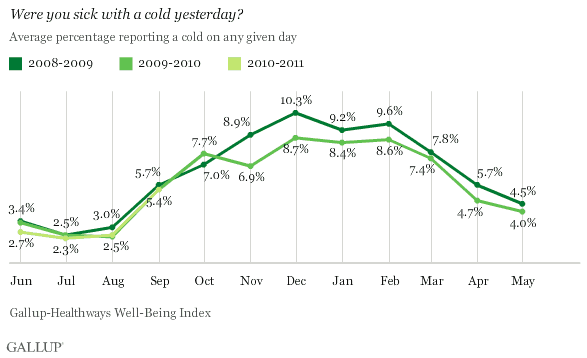WASHINGTON, D.C. -- Cold and flu season is now underway, and Gallup-Healthways Well-Being Index tracking finds that Americans' self-reports of the flu are typical so far, with 1.7% reporting the flu on any given day in September, on par with the same month in 2009 and 2008. These findings provide early support for the Centers for Disease Control and Prevention's projections, which are tempered compared with last season's concerns about widespread outbreaks as a result of H1N1 that never came to fruition.

By asking 1,000 Americans each day whether they had a cold and the flu "yesterday," the data provide insight into the prevalence of these conditions month over month throughout the course of the season.
The measurement of colds vs. the flu in a survey research environment is complex because of the overlapping symptoms of the two disease conditions and many Americans' misunderstanding of what symptoms constitute "the flu" versus "a cold." But the Gallup-Healthways Well-Being Index continuous tracking allows for month-over-month and year-over-year comparisons, which provide useful insight into the overall prevalence trend. In general, the percentage of Americans who report having had a cold yesterday is roughly three times those who report having the flu yesterday. It is also possible that the estimate of daily cold and flu prevalence is somewhat underestimated, as would-be respondents who were sick the day before may be less likely to respond to a phone survey the next day than those who were not.
Colds on the Rise in September, but Tracking Similar to 2009 and 2008
The percentage of Americans reporting having had colds in the past four months is similar to the corresponding months in 2009 and 2008. The 5.4% in September is similar to the same month last year and, if the usual trend continues, is likely to increase to around 7% in October.

Bottom Line
October was the only month of the 2009-2010 cold and flu season in which colds and flu were higher than what was measured during the 2008-2009 season, with each ensuing month tracking lower. It is too early to determine whether the 2010-2011 cold and flu season will look more like the one that occurred last year or the year before.
Public health officials from the Centers for Disease Control and Prevention (CDC) are predicting a normal cold and flu season this year, therefore estimating that between 5% and 20% of the population is expected to contract the flu and at least 200,000 persons are expected to be hospitalized with seasonal flu-related conditions. This contrasts with the dire projections hyped in the summer of 2009 for the 2009-2010 season as a result of the outbreak of the H1N1 pandemic.
The CDC recently found that as a result of vaccinations and prior infections by H1N1 or H1N1-related viruses, 59% of the American population is now immune to H1N1. Flu vaccinations this season contain seasonal influenza and pandemic H1N1 components, making them much more effective in early prevention compared with last season. Consequently, cautious optimism for a typical season is widespread, although tens of millions of Americans remain at risk, particularly those younger than 57 years of age (who would not have been exposed to H1N1-like viruses decades ago) and those with previously existing chronic conditions.
优蜜传媒will continue to track self-reported cold and flu cases throughout the 2010-2011 season.
Results are based on telephone interviews conducted as part of the Gallup-Healthways Well-Being Index surveys each day, with a random sample of at least 1,000 adults, or roughly 30,000 adults per month, aged 18 and older, living in all 50 U.S. states and the District of Columbia, selected using random-digit-dial sampling.
For results based on the total sample of national adults, one can say with 95% confidence that the maximum margin of sampling error is 卤0.6 percentage point.
One of the questions asked each day is, "Were you sick with any of the following yesterday?" The question specifies four illnesses: the flu, a cold, a headache, and allergies. Respondents are not asked to indicate whether they had received a clinical diagnosis of H1N1 or other types of influenza via a healthcare professional.
Interviews are conducted with respondents on landline telephones and cellular phones, with interviews conducted in Spanish for respondents who are primarily Spanish-speaking. Each daily sample includes a minimum quota of 150 cell phone respondents and 850 landline respondents, with additional minimum quotas among landline respondents for gender within region. Landline respondents are chosen at random within each household on the basis of which member had the most recent birthday.
Samples are weighted by gender, age, race, Hispanic ethnicity, education, region, adults in the household, cell phone-only status, cell phone-mostly status, and phone lines. Demographic weighting targets are based on the March 2009 Current Population Survey figures for the aged 18 and older non-institutionalized population living in U.S. telephone households. All reported margins of sampling error include the computed design effects for weighting and sample design.
In addition to sampling error, question wording and practical difficulties in conducting surveys can introduce error or bias into the findings of public opinion polls.
For more details on Gallup's polling methodology, visit .
